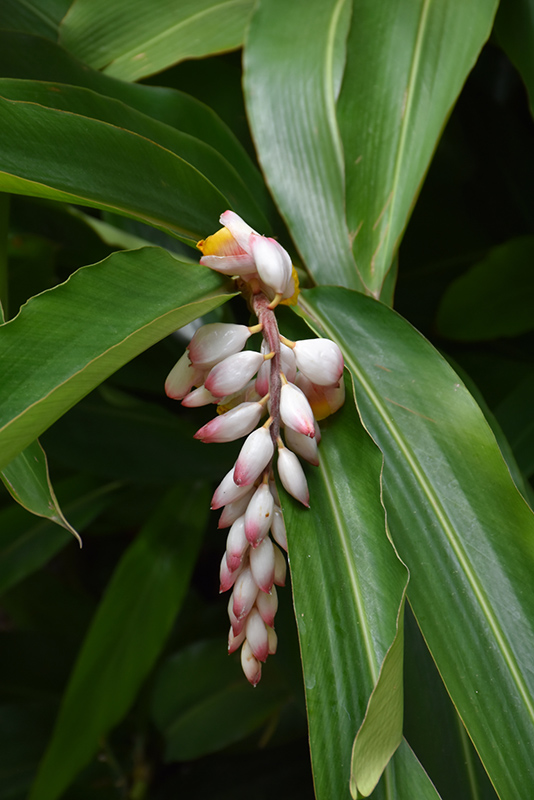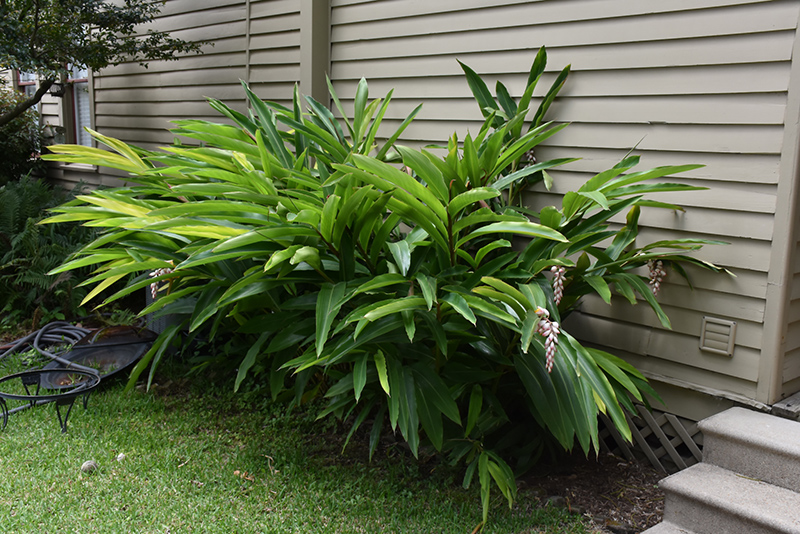Height: 4 feet
Spread: 4 feet
Sunlight:
![]()
Hardiness Zone: 9a
Description:
A root spice that is consumed worldwide for culinary and medical purposes; long elegant leaves unfurl from pseudostems and arch gracefully; seasonal clusters of white buds open to reveal pale yellow and crimson flowers; great for herb gardens or borders
Edible Qualities
Common Ginger is a perennial herb that is commonly grown for its edible qualities, although it does have ornamental merits as well. It produces tan oblong roots with yellow flesh which are typically harvested when mature. The roots have a potent taste with a hard texture and a distinctive fragrance.
The roots are most often used in the following ways:
- Cooking
- Baking
- Seasoning
- Tea
Features & Attributes
Common Ginger's attractive glossy sword-like leaves emerge chartreuse in spring, turning forest green in color the rest of the year on a plant with an arching habit of growth.
This is an herbaceous evergreen perennial herb with a shapely form and gracefully arching stems. Its relatively coarse texture can be used to stand it apart from other garden plants with finer foliage. This plant will require occasional maintenance and upkeep, and is best cleaned up in early spring before it resumes active growth for the season. It has no significant negative characteristics.
Aside from its primary use as an edible, Common Ginger is sutiable for the following landscape applications;
- Mass Planting
- General Garden Use
- Herb Gardens
- Container Planting
Planting & Growing
Common Ginger will grow to be about 4 feet tall at maturity, with a spread of 4 feet. It has a low canopy with a typical clearance of 1 foot from the ground. It grows at a fast rate, and under ideal conditions can be expected to live for approximately 10 years. As an evegreen perennial, this plant will typically keep its form and foliage year-round.
This plant is quite ornamental as well as edible, and is as much at home in a landscape or flower garden as it is in a designated herb garden. It should be grown in a location with partial shade. Keep it away from hot, dry locations that receive direct afternoon sun or which get reflected sunlight, such as against the south side of a white wall. It is quite adaptable, prefering to grow in average to wet conditions, and will even tolerate some standing water. It may require supplemental watering during periods of drought or extended heat. It is not particular as to soil pH, but grows best in rich soils. It is somewhat tolerant of urban pollution. This species is not originally from North America. It can be propagated by division.
Common Ginger is a good choice for the edible garden, but it is also well-suited for use in outdoor pots and containers. Because of its height, it is often used as a 'thriller' in the 'spiller-thriller-filler' container combination; plant it near the center of the pot, surrounded by smaller plants and those that spill over the edges. It is even sizeable enough that it can be grown alone in a suitable container. Note that when growing plants in outdoor containers and baskets, they may require more frequent waterings than they would in the yard or garden.
Disclaimer - This Plant Finder tool is an online resource representing many of the varieties that we carry over the course of the season, and is intended for informational purposes only. Inventory varies seasonally, so we cannot guarantee that every plant will be in stock at all times - please contact the store directly for current availability. It does not include our entire selection of plants, so be sure to visit our store to see varieties that may not be represented on this list.


